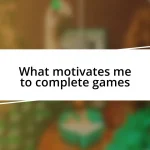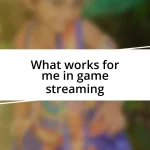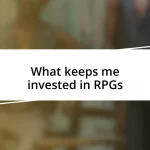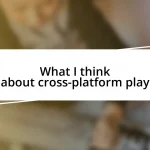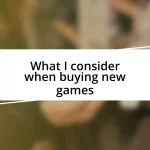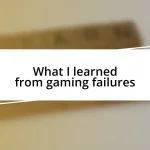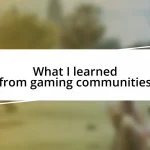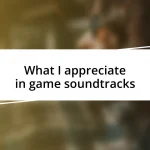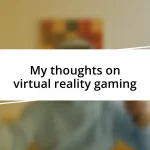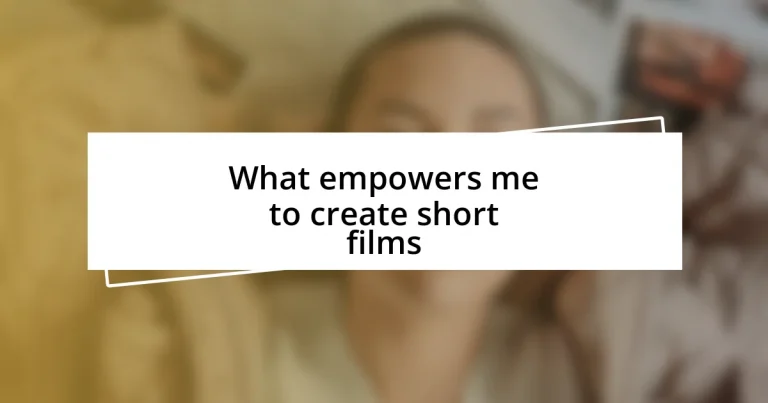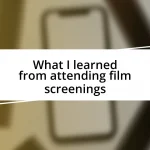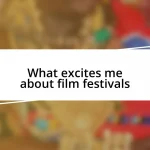Key takeaways:
- Creative motivation is fueled by personal experiences and the desire to connect with others through relatable stories.
- Technical skills such as cinematography, sound design, and editing elevate storytelling, enhancing emotional engagement with the audience.
- Collaboration with other creatives and gathering feedback are crucial for refining projects and fostering growth as a filmmaker.
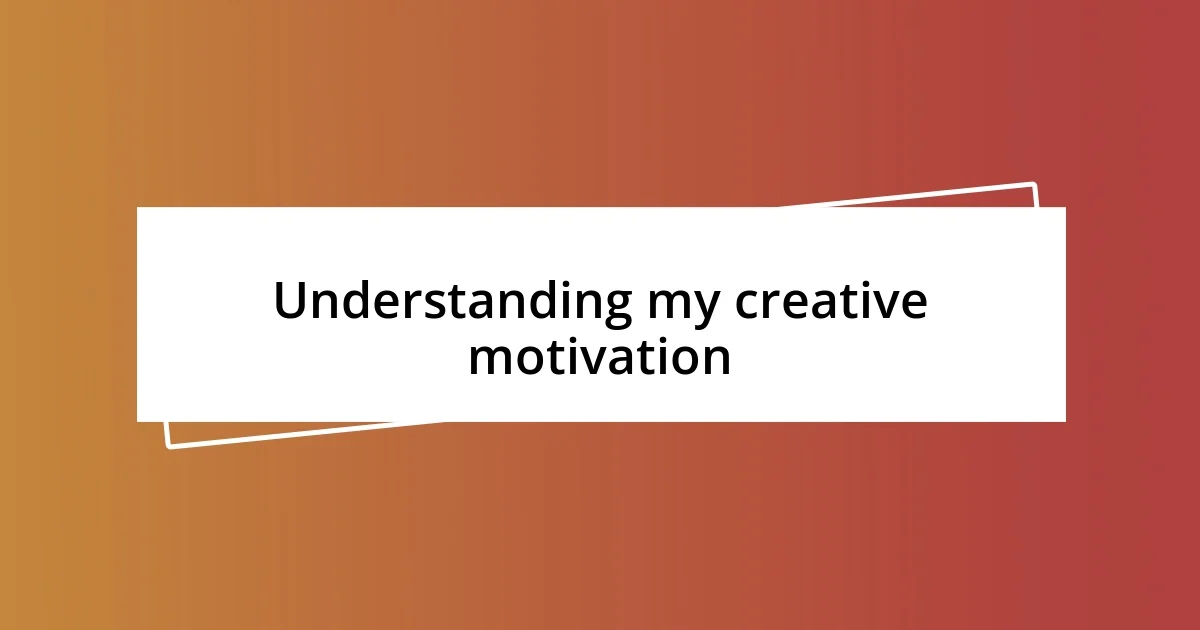
Understanding my creative motivation
As I reflect on my creative journey, I realize that my motivation often stems from a blend of personal experiences and the desire to convey relatable stories. I still remember the thrill of watching a film that resonated with my struggles, making me wonder: how can I evoke that same feeling in others? This connection drives me to explore themes that resonate deeply, often reflecting my own uncertainties and passions.
There’s something magical about the process of transforming my thoughts into visual narratives. I often find inspiration during quiet moments, like sipping coffee at sunrise. It’s in these peaceful times that ideas flow naturally, sparking an urge to create. Have you ever felt that rush of adrenaline just before starting a project? It’s that feeling of possibility that keeps me energized and eager to share my vision with the world.
Of course, challenges come and go. Sometimes, I get stuck, questioning whether my voice truly matters. But then, I remind myself of the films that once changed my perspective—the works that challenged societal norms or showcased raw emotions with authenticity. This realization fuels my determination. What if my next film could do the same for someone else? It’s this question that propels me forward, reminding me why I love to create.
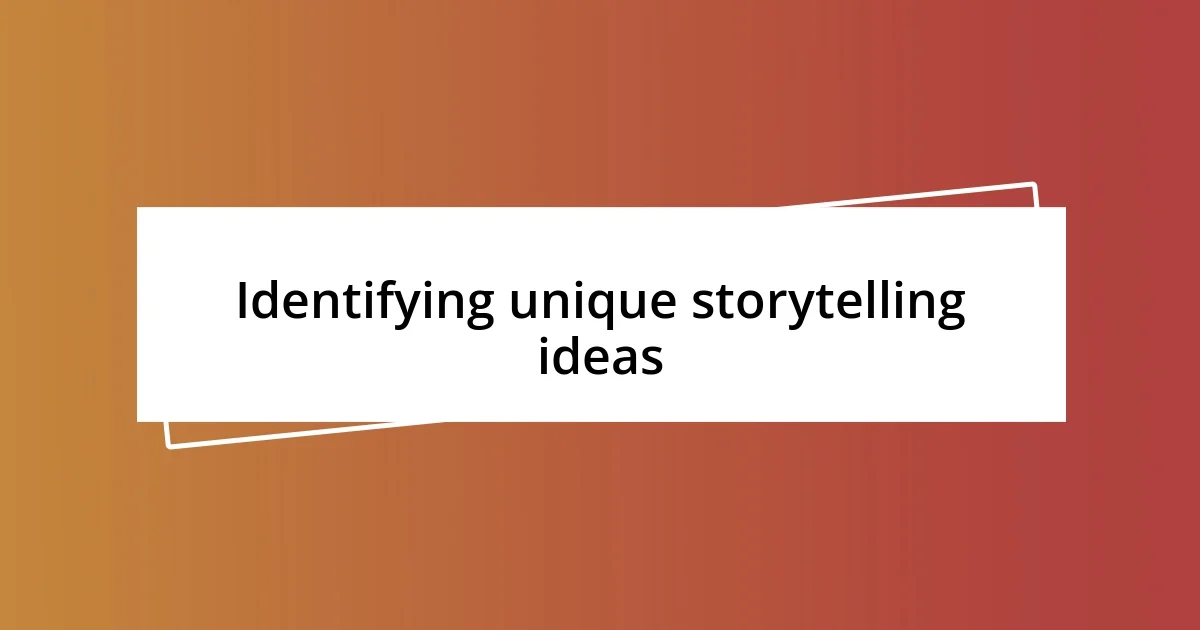
Identifying unique storytelling ideas
Identifying unique storytelling ideas often involves diving deep into our own experiences and emotions. I vividly recall a time when I was stuck in traffic, feeling frustrated and isolated. Instead of letting that moment slip away, I transformed it into a story about connection—how people sitting in close proximity can feel miles apart. It’s surprising how everyday moments can trigger unique narratives just by reflecting on what we encounter.
To uncover fresh storytelling ideas, I often turn to these practices:
- Journaling daily thoughts and observations: Writing down fleeting ideas can reveal hidden patterns.
- Exploring diverse cultures and communities: Engaging with different perspectives opens up new narrative opportunities.
- Listening to people’s stories: I find that everyone has a tale to tell; sometimes, the most ordinary lives harbor extraordinary moments.
- Setting creative constraints: Limiting the scope of a story can spark innovative solutions and original plots.
- Experimenting with genres: Merging different storytelling styles can lead to unexpected, compelling narratives.
By inviting inspiration into our daily lives and connecting with the stories around us, we pave the way for unique creative expressions that resonate with others.
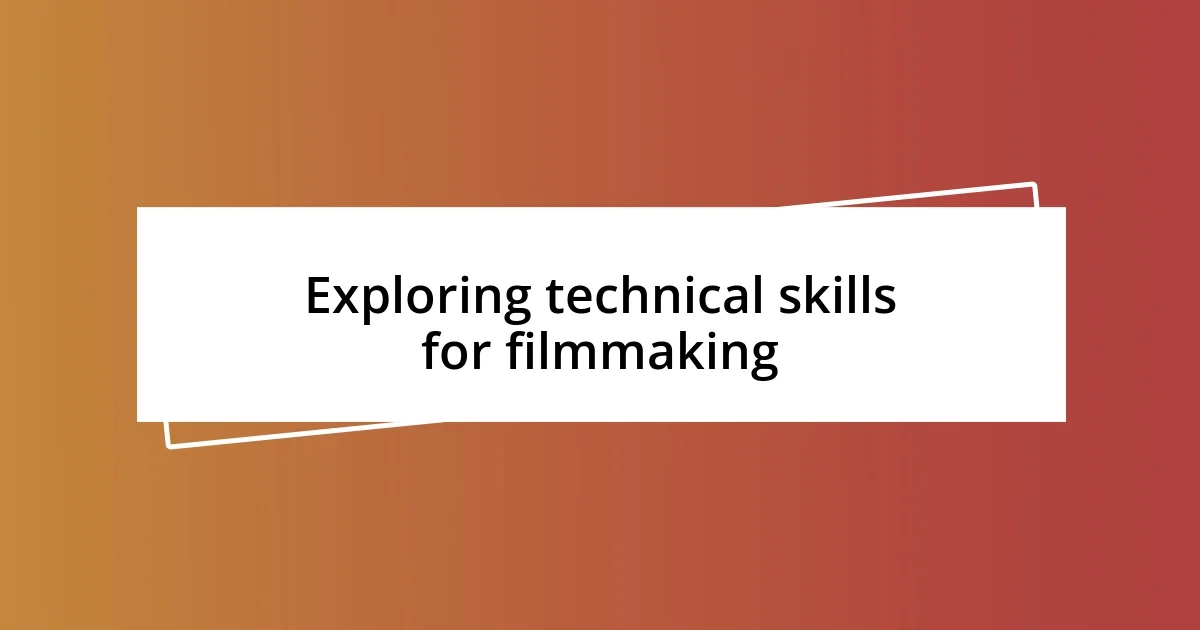
Exploring technical skills for filmmaking
Exploring technical skills in filmmaking is an essential part of the creative process. I’ve found that mastering the technical aspects can truly elevate storytelling. For instance, learning about camera angles and lighting has opened up a whole new world for my projects. I can vividly remember the first time I experimented with soft lighting. It transformed a dimly lit scene into something magical. It’s all about drawing out the emotions and creating a mood that resonates with viewers.
Sound design is another critical technical skill that I often emphasize. There’s a fascinating power in how sound can influence one’s emotional state during a film. I recall a project where I incorporated ambient sounds to create a sense of place. The little chirps of birds, rustling leaves, and even distant conversations transformed the scene into something intensely atmospheric. It’s incredible how technical skills collectively enhance a narrative, helping it to speak volumes even without dialogue.
Editing is perhaps the skill that ties everything together. I’ve spent countless hours both in the editing room and at my desk, piecing together stories frame by frame. It’s like solving a puzzle where timing is everything. I once edited a short film late into the night, reshaping an entire scene based on rhythm and flow, which turned it into a highlight of the film. Getting technical skills right not only brings your story to life but also connects you to the audience in a way that feels both powerful and intimate.
| Technical Skill | Importance |
|---|---|
| Cinematography | It captures the visual essence, influencing mood and engagement. |
| Sound Design | It enhances the story’s emotional impact and immerses the audience. |
| Editing | It shapes the narrative, controlling pacing and flow for maximum effect. |
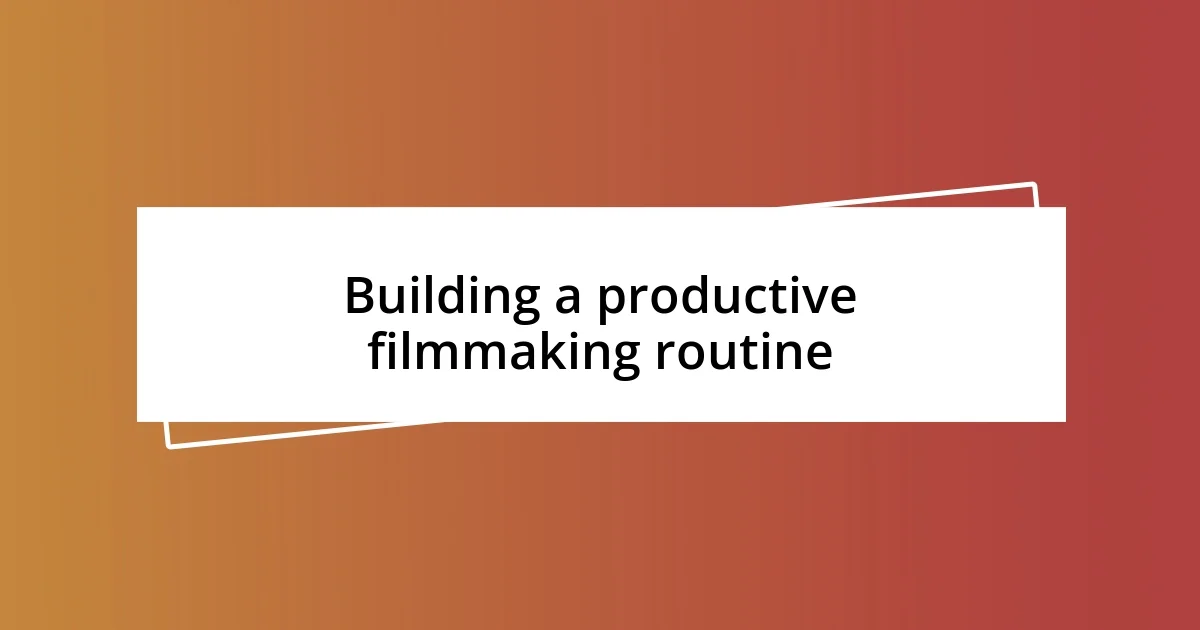
Building a productive filmmaking routine
Building a productive filmmaking routine is crucial for turning inspiration into action. I often start my day with a dedicated block of time reserved solely for brainstorming and storyboarding. There’s something magical about putting pen to paper and letting ideas flow without interruption. Have you ever tried that? It can feel liberating to watch your thoughts transform into visual outlines.
To keep my creativity alive, I establish small daily goals that align with my larger projects. This might involve shooting a few scenes or experimenting with lighting techniques. Recently, I committed to a “30 Days of Filmmaking” challenge, where I produced a short clip every day. It forced me to push boundaries and, surprisingly, some of the best ideas emerged under pressure. The excitement of creating consistently sparks even more creativity, don’t you think?
Additionally, I’ve learned the power of reflection. After each project, I take time to review what worked and what didn’t—almost like a post-game analysis. I remember a time when I struggled with pacing in a short film. I took a step back and realized that I hadn’t given my characters enough downtime to breathe. Adjusting that made all the difference! Reflective practices not only inform future projects but also foster growth as a filmmaker. By nurturing that routine, we continually evolve and strengthen our creative voice.
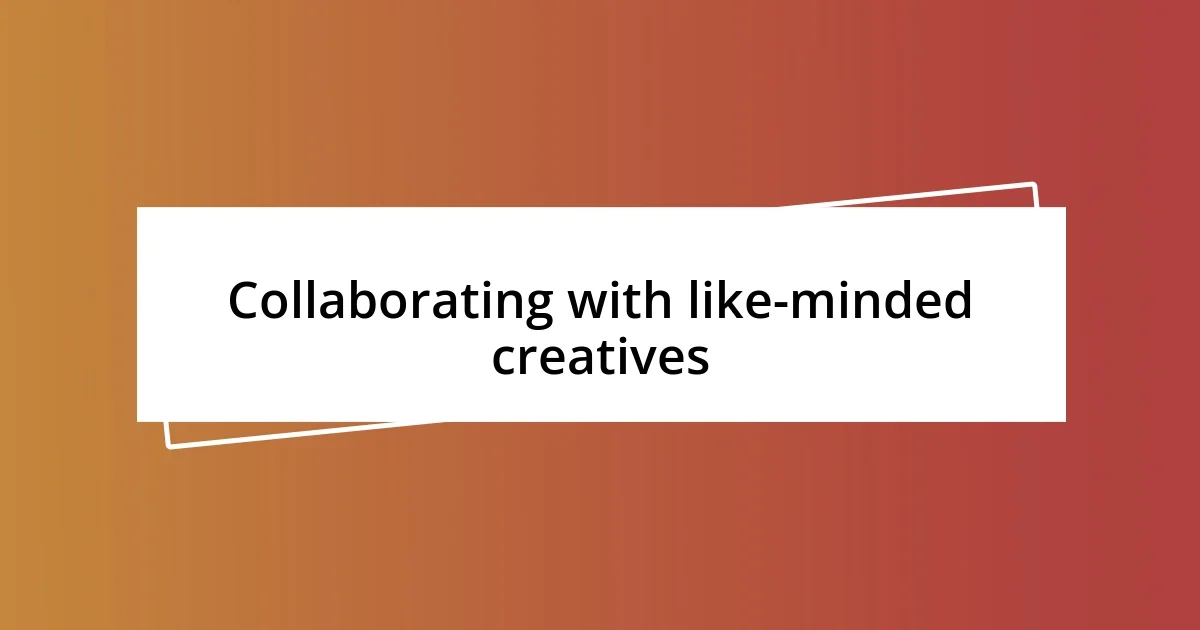
Collaborating with like-minded creatives
Collaborating with like-minded creatives is an experience that can ignite inspiration like nothing else. I vividly remember the first time I worked with a friend who shared my passion for storytelling; our brainstorming sessions felt like a creative orchestra, with each idea building upon the last. Have you ever felt that rush when everyone in the room is equally invested? It’s electric.
I’m often fascinated by how different perspectives can enrich a project. For instance, during one collaboration, a fellow filmmaker introduced me to a unique editing style that I hadn’t considered before. It was an eye-opening moment, revealing layers to my story that I hadn’t even realized were there. The synergy between passionate creatives is powerful; it turns ordinary ideas into extraordinary narratives.
There’s something incredibly rewarding about combining strengths with others who share your vision. I once worked on a short film where the cinematographer had a knack for capturing raw emotion, while my strength lay in crafting dialogue. Merging these skills resulted in a project that felt holistic and resonated deeply with audiences. Isn’t it amazing how collaboration can elevate the final piece, transcending the sum of its parts?
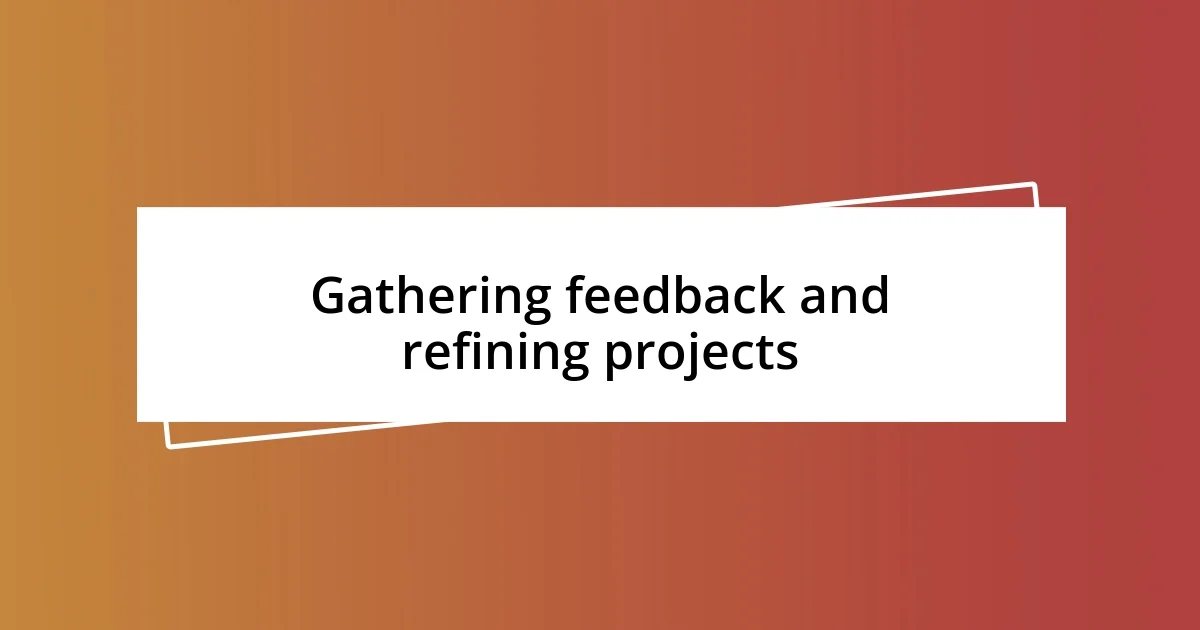
Gathering feedback and refining projects
Gathering feedback is an integral part of my filmmaking process. I remember screening my latest short film for a close-knit group of friends and fellow filmmakers. The moment I heard their honest reactions—some positive, some critical—I felt a rush of clarity. Have you ever noticed how outside perspectives can unveil aspects of your work that you might overlook? Their insights sparked fresh ideas for refining the narrative and improving pacing, ultimately leading to a stronger final cut.
After receiving feedback, I dive into the refinement phase with a keen eye. I often revisit my scripts, making adjustments based on the suggestions I’ve received. For instance, there was a time when a scene I thought was perfect fell flat during screenings. Feedback indicated that the emotional impact wasn’t landing as intended. I took a deep breath and rewrote the dialogue, adding layers of nuance that ultimately resonated with viewers. It’s almost like polishing a gemstone—sometimes, it takes a bit more shine to truly reflect its beauty.
I also value formal feedback sessions where I can engage in discussions with mentors. During one of these experiences, a seasoned filmmaker pointed out how useful structured critique can be for growth. This dialogue not only pushed me to refine my work but also instilled confidence to trust my instincts. How vital it is to learn from every piece of feedback processed! Each session reminds me that filmmaking is as much about collaboration with others as it is about my personal vision.

Sharing films to build an audience
Sharing my films with an audience is a thrilling step in the creative journey. I’ve had moments where screening my short films in local film festivals led to unexpected connections with fellow enthusiasts. It’s incredible how shared storytelling can forge a sense of community; have you ever experienced that warm buzz when you see someone smile during a pivotal scene? The feedback that flows after such screenings often feels like a conversation about life itself, deepening my understanding of how my work resonates.
Social media has become a cornerstone for sharing my films. Platforms like Instagram and Twitter allow me to tap into niche communities that genuinely appreciate the craft. I recall posting a teaser for my latest project and, within hours, received thoughtful comments and shares from people I hadn’t met before. It astounded me how a simple post could spark discussions about themes I thought were only personal to me. Isn’t it fascinating how digital spaces can expand our reach in unimaginable ways?
Engaging with my audience doesn’t stop at just showcasing my films; it’s about fostering dialogue. After a screening, I often find myself standing near the exit, ready to chat with anyone willing to share their thoughts. I still remember a conversation I had after one of my films; a viewer mentioned how a character’s struggle mirrored their own life experiences. Hearing such connections is deeply moving; it solidifies my belief that sharing films is not just an act of showcasing creativity but also a way to touch lives, build empathy, and inspire further storytelling. How fulfilling it is to realize that my art can ignite conversations that matter!
